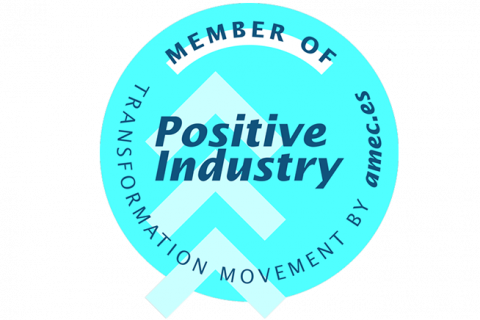
-
Company
-
We talk your language
TMI is your partner for bagging, palletizing and stretch-wapping systems.
- About us
- Talented people
- News
-
-
Solutions
-
Complete bagging lines
TMI manufactures complete bagging lines: from the dosing of the finished product to the protection of the load. We supply bagging machines, palletizers and stretch-wrapping systems that suit your needs. Browse through our portfolio and find the optimal solution for your end of line.
- Bagging systems
- Bag palletizing systems
- Pallet stretch-wrapping
- Industry 4.0
-
-
Industries
-
Solutions that fit your project
We develop bagging and palletizing solutions for different industries. Choose yours to see the solutions that best suit your needs.
- Food
- Agri-food
- Chemicals & petrochemicals
- Construction & mining
- Recycling
-
- Services
- Contact
- Ask for a quotation
-
Company
-
We talk your language
TMI is your partner for bagging, palletizing and stretch-wapping systems.
-
-
Solutions
-
Complete bagging lines
TMI manufactures complete bagging lines: from the dosing of the finished product to the protection of the load. We supply bagging machines, palletizers and stretch-wrapping systems that suit your needs. Browse through our portfolio and find the optimal solution for your end of line.
-
-
Industries
-
Solutions that fit your project
We develop bagging and palletizing solutions for different industries. Choose yours to see the solutions that best suit your needs.
-
- Services
- Contact
UL Certification: Accessing the American Market for Electrical Components and Industrial Machinery
December 27, 2024
In the markets of North America, Central America, and some South American countries, UL certification is an essential requirement for manufacturers of electrical components.
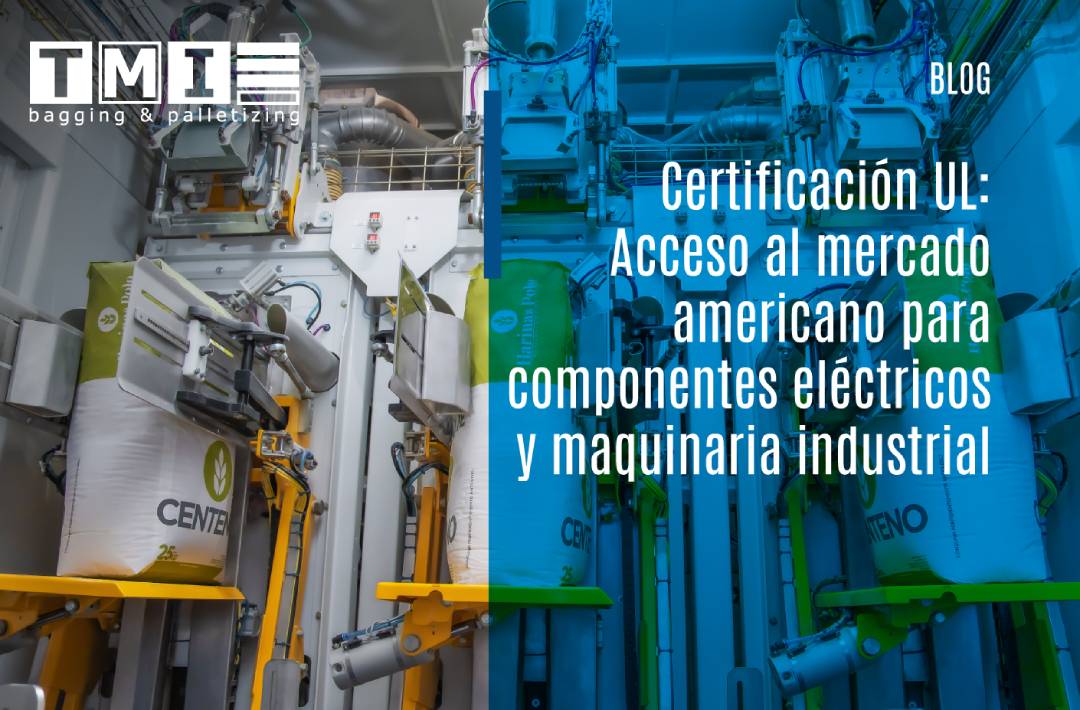
In the markets of North America, Central America, and some South American countries, UL certification is an essential requirement for manufacturers of electrical components, control panels (industrial control panels), and industrial machinery. Compliance with this standard is necessary to ensure legal conformity and enhance trust in your products.
In this sense, UL self-certification allows manufacturers and panel builders to streamline this process and quickly adapt to the requirements of this market.
In this article, we explore what UL certification is, the main types of markings available, and how TMI addresses these requirements to ensure products comply with the specific regulations of each market.
What is UL, and why is it crucial for the North American market?
UL, or Underwriters Laboratories, is an independent organization dedicated to establishing safety and quality standards for a wide range of products.
Its relevance lies in the need for markets in the USA, Canada, and other American countries to ensure that electrical equipment and machinery meet specific quality and safety requirements, such as those stipulated in the NFPA 70 (National Electrical Code or NEC).

Illustration 1: Global Market (Source: ul.com)
Types of UL Certification
From an industrial perspective, UL certification ensures that components or equipment carry specific markings that certify compliance with these standards.
The main certifications in this regard include:
- Certification of electrical components.
- Certification of electrical control panels.
- Certification of industrial machinery.
Depending on the product's characteristics, these markings can be classified as follows:
- "Listed" (Listed): Indicates that the product complies with all relevant UL standards and is registered in UL's official database, available for public consultation.
- "Classified" (Classified): The product has been evaluated for specific properties, limited risks, or particular conditions of use.
- "Recognized" (Recognized): Applies to components designed to be part of a final product and not for independent use.
Additionally, UL markings may specify whether the product complies with applicable regulations in the USA, Canada, Europe, or other markets.
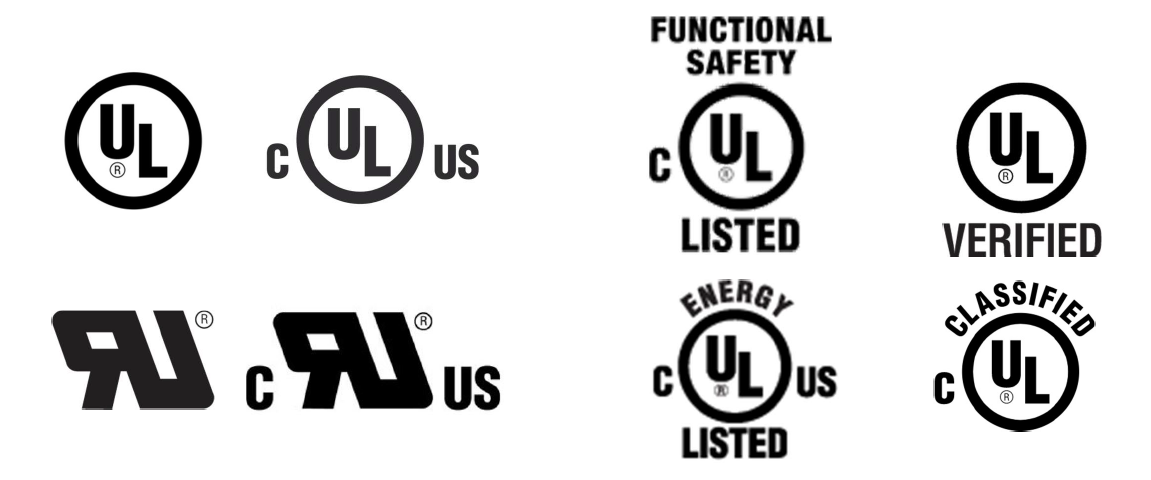
Illustration 2: UL Markings, some common examples
(Source: ul.com)

Illustration 3: Examples of UL markings for electrical panels
Standards, Regulations, and Codes for UL Certification
While there is a global trend toward harmonizing regulations across countries and continents, significant differences still exist. For example, in the case of industrial control panels and machinery, the American market requires consideration of the following standards:
- UL 508A: Electrical Control Panel Certification. This standard regulates the design and construction of industrial control panels used in applications like HVAC systems, manufacturing machinery, and industrial plants. Key requirements include proper component sizing, appropriate wiring, and compliance with NFPA 70 (NEC).
- UL 2011: Industrial Machinery Certification. Designed to ensure that machines comply with safety standards in industrial environments, based on NFPA 79 guidelines. It can be considered equivalent to the Machinery Directive in Europe. Requirements include integrating safety systems, protection against electrical overloads, and operational risk control.
- NFPA 70 (NEC): National Electrical Code. The NEC establishes standards for the safe installation of electrical equipment in the USA, covering system design, installation, and review. It is equivalent to the Low Voltage Regulation in Spain. UL certification ensures compliance with the NEC, making products acceptable during inspections.
- NFPA 79: Electrical Safety Standard for Industrial Machinery. Focuses on protecting operators and equipment from electrical and fire hazards.
- ANSI (American National Standards Institute). Similar to AENOR in Spain, it develops standards for products, services, and processes.
- OSHA (Occupational Safety and Health Administration). A governmental agency regulating workplace safety and health.
How TMI Addresses UL Certification
At TMI, we work to ensure that our projects meet the specific requirements of the Canadian and U.S. markets. Our approach includes:
- Self-certification of electrical control panels: We have personnel accredited as Manufacturer Technical Representatives (MTR), ensuring that our technicians possess the necessary knowledge to apply the UL 508A standard. This accreditation is personal, non-transferable, and must be renewed every three years.
- Use of certified components: In our projects, we use electrical components with UL markings, ensuring their compatibility with local regulations.
- Customer support for machinery certification: We provide all necessary technical documentation for our clients to certify machinery at their facilities.
Through these practices, we help our clients comply with the strictest regulations and access North American markets with complete confidence.

Illustration 2: Installation Diagram vs. Standard and/or Code(Source: ul.com)
Benefits of UL Certification
UL certification offers key advantages in our projects:
- Cost reduction: By avoiding recurring external certifications, significant costs are saved during the process.
- Speed: Products reach our customers faster by eliminating dependency on third parties.
- Total control: As manufacturers, we have control over testing and documentation, ensuring that products meet clients' specific requirements.
- Flexibility: Facilitates adaptation to changing requirements in the USA and Canadian markets, such as updates to the NFPA 70 (NEC).
UL Certification for the American Market by TMI
UL certification is both a technical requirement and a strategic tool for accessing regulated markets, ensuring safe and high-quality products.
At TMI, we combine technical expertise and regulatory knowledge to simplify this process for our clients, ensuring their products meet the stringent standards required in the USA, Canada, and other applicable regions while reducing costs and timeframes.
If you need advice or support for this process, our team is ready to help you comply with the market's most demanding standards. Contact us for more information.
Differences Between Manual and Automatic Bagging Machines: How to Choose the Best Option
October 29, 2024
When dealing with bulk products and their packaging, the choice between a manual or automatic bagging machine can significantly impact the end of the production line.
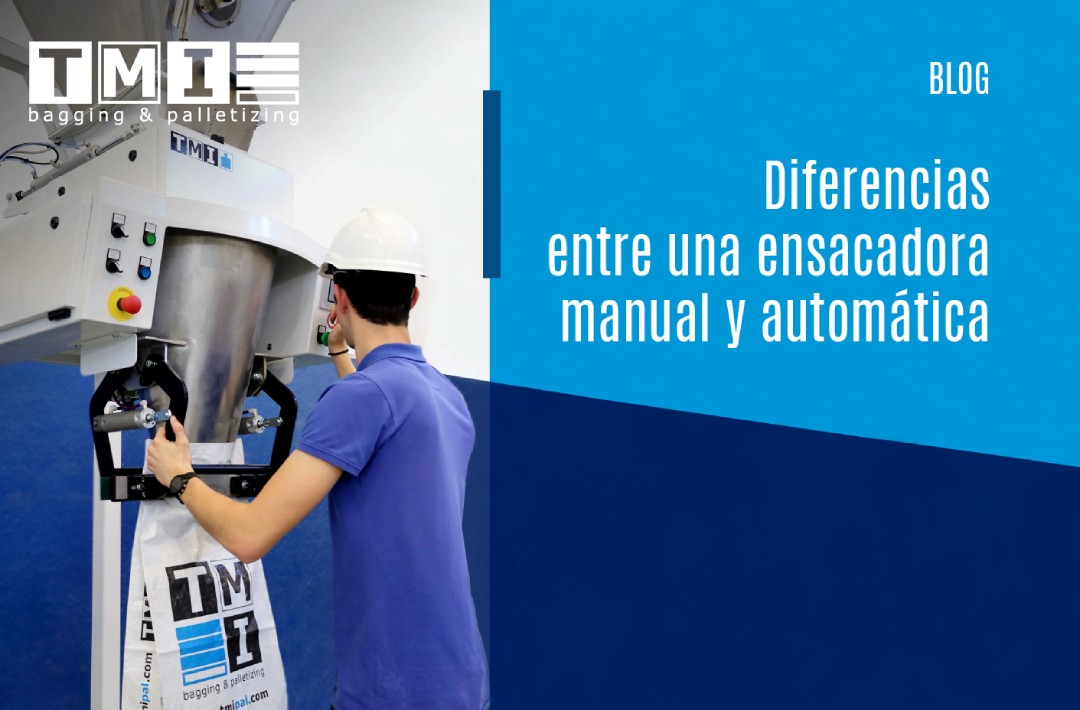
When dealing with bulk products and their packaging, the choice between a manual or automatic bagging machine can significantly impact the end of the production line. Depending on each product and its technical requirements (different batch sizes, cleaning requirements, sealing needs, etc.), along with other investment and return criteria, choosing between a manual or automatic bagging machine is not always an easy decision.
Each type of bagging machine has advantages that can benefit different types of businesses. At TMI, we have extensive experience in the development, installation, and maintenance of industrial bagging machinery. We understand our clients' needs and guide them in making this decision. This article will help you identify the ideal option for you.
Why Is It Important to Choose the Right Bagging Machine?
Selecting the appropriate bagging machine directly impacts productivity, operational costs, and your processes' adaptability. Depending on the degree of personnel intervention, bagging machines can be categorized as automatic (with minimal human intervention - supervision) and manual or semi-automatic (with human intervention at some point).
While logic might dictate that an automatic bagging machine should be the preferred option, various factors should be considered before making a decision. Below, we summarize the most important characteristics and advantages of each type of bagging machine.
Manual or Semi-Automatic Bagging Machines: Characteristics and Advantages
A manual or semi-automatic bagging machine requires human intervention, for example, to position bags, manually start filling cycles, and/or remove filled bags. These machines are responsible for weighing, dosing, and inserting the product into the bag based on the specified requirements, recording production data (products, weight, productivity in bags/hour, etc.).
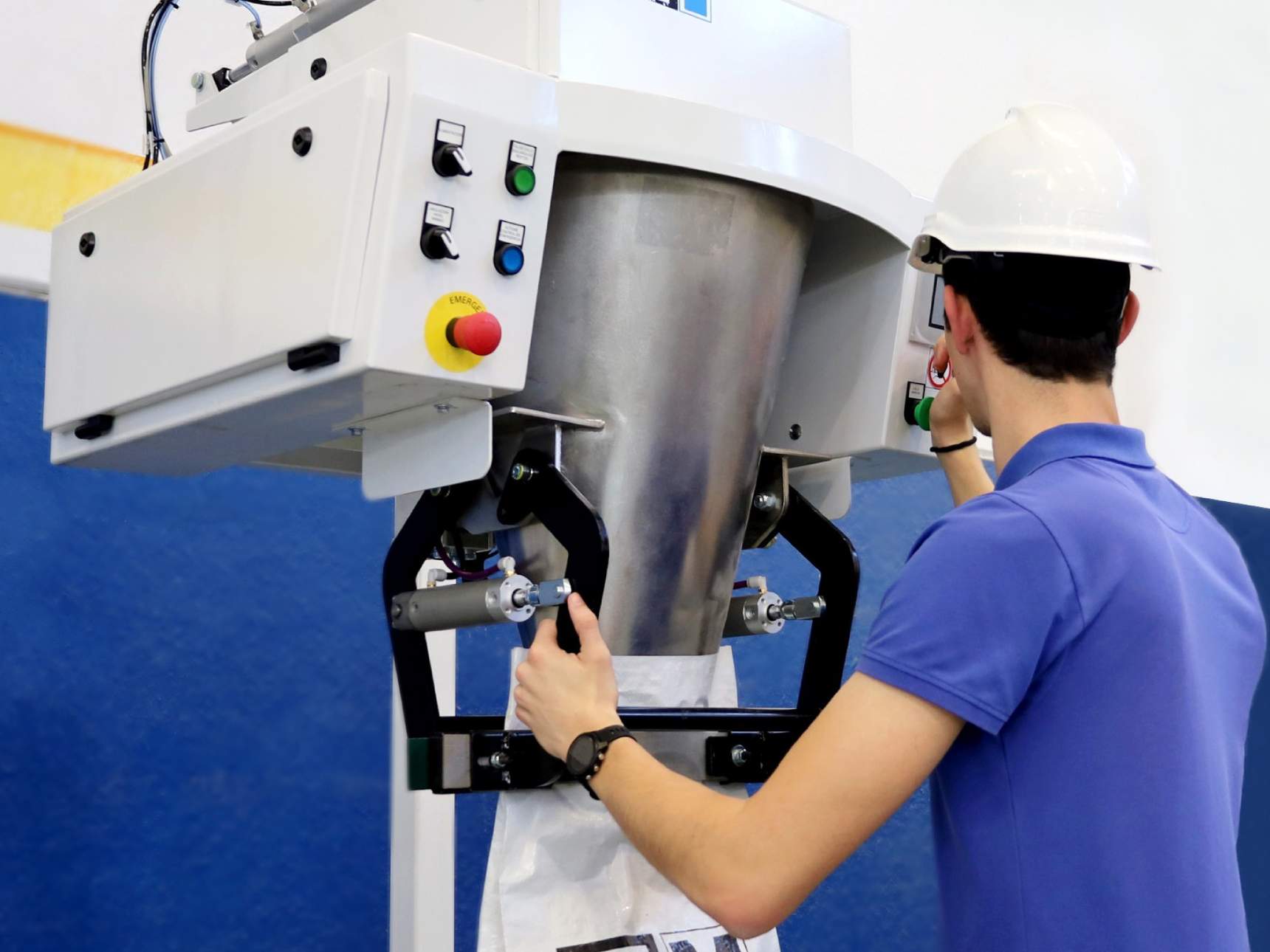
Advantages of Manual Bagging Machines
- Lower Initial Cost: These machines have a lower initial investment compared to automatic ones, making them an attractive option for companies with tight budgets.
- Complete Process Control: Human intervention allows greater control at each stage, ideal for operations needing immediate flexibility or adaptability.
- Versatility and Flexibility: Perfect for smaller-scale operations or those requiring frequent configuration changes.
- Simple Start-Up: Installing this machinery is faster and simpler, usually requiring minimal training for staff to operate it.
- Easy Cleaning and Maintenance: Cleaning and maintenance tasks are generally quicker on these machines.
When Is It Better to Choose a Manual Bagging Machine?
Manual bagging machines are flexible machines that can be used in various processes to bag products weighing between 5 and 50 kg. They are recommended for:
- Industries processing small, varied batches with frequent recipe changes.
- Industries with small or medium production volumes or those just starting out.
- Industries with plenty of available labor.
- Situations with limited budgets.
- Limited space for installation.
TMI offers a wide range of semi-automatic bagging machines. Here are some models: ILERFIL AB, ILERFIL ABS, ILERFIL AN, ILERFIL VBG, and ILERFIL VBF.
Automatic Bagging Machines: Characteristics and Advantages
Automatic bagging machines, on the other hand, handle the entire bagging process automatically, from loading to sealing the bag, with minimal human intervention, limited to start-up, supervision, or replenishment of consumables. In other words, they perform the same function, but in this case, all operations are automated: bag placement, dosing, filling, sealing, removal, and even palletizing.
As expected, the technology used in automatic bagging machines is more advanced than in manual ones and may include features like a hopper vibration system to prevent sticky products (such as additives with high-fat content) from adhering; different sealing or closing systems (sewing, heat-sealing, cutting and sealing, etc.); or even bag preparation from a roll.
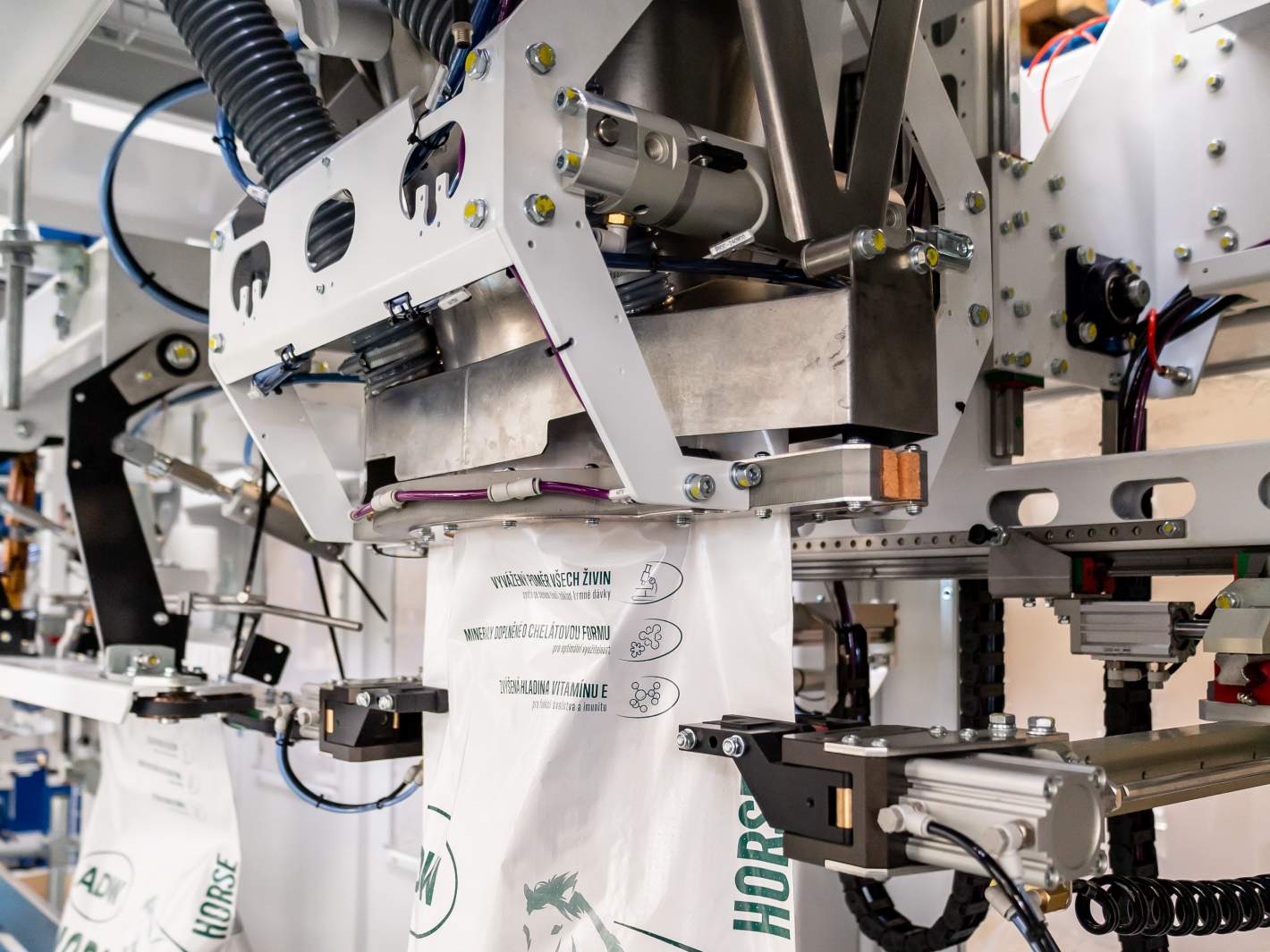
Advantages of Automatic Bagging Machines
- High Production Capacity: These machines are designed to handle large volumes quickly and efficiently.
- Reduction of Human Errors: Process automation minimizes errors and ensures greater consistency in the final product.
- Long-Term Efficiency: Although the initial investment is higher, reduced labor costs and increased production offer a faster return on investment.
- Bag Positioning: These machines allow total control over bag positioning and optimal closure.
- Cleaner Environment: The workspace remains cleaner and safer.
- Less Need for Personnel: Only general supervision of the system and consumable replenishment are required.
- More Packaging Variety: Automatic bagging machines handle different types of bags and materials: flat bags or gusseted bags, paper, polyethylene, or woven polypropylene (WPP) bags, SOS bags, valve bags, FFS (Form-Fill-Seal) bags, etc.
When Is It Better to Choose an Automatic Bagging Machine?
This type of bagging machine is ideal for:
- Industries with large volumes of continuous production.
- Companies where labor is a limited resource.
- Industries requiring an optimal packaging finish.
- Situations aimed at reducing labor costs in the long term and/or improving return on investment.
At TMI, we offer automatic bagging machines for different types of bags: open-mouth baggers, SOS baggers, valve baggers, and FFS baggers.
Manual or Automatic Bagging Machine: Which Is Better for You?
Here are the main factors you should consider when choosing the best type of bagging machine for your company:
- Production Volume: If your operation handles low or medium volumes, a manual bagger may be sufficient. For high volumes and continuous production, the automatic option is most suitable.
- Budget: Manual bagging machines are more accessible in terms of initial investment, while automatic ones offer a higher return in the long term due to their ability to optimize production.
- Maintenance: Automatic machines require more specialized maintenance, but at TMI, we offer maintenance plans tailored to your needs to ensure your machinery operates at peak performance at all times.
- Scalability: If your company is growing, an automatic bagger will allow you to adapt to future production needs without requiring significant additional investment in machinery.
- Available Space: A key factor is the space you have at the end of the line to deploy the bagging system, as automatic machines generally require more space.
- Available Workforce: Do you have ample labor available in your plant, or is it a scarce resource? If you don't have much staff, the option to invest in automation is appealing.
At TMI, we help you make the right decision.
The choice between a manual and an automatic bagging machine depends on various factors and can be a complex decision. At TMI, we are here to offer you expert advice. With decades of experience helping businesses of all sizes decide on the appropriate machinery for their bagging processes, we’re here to help.
For more information or advice, contact us without obligation.
MULTIDISCIPLINARY TEAMS AND THE ARTE METHODOLOGY: KEY TO SUCCESS IN PROJECT MANAGEMENT
September 26, 2024
In bagging and palletizing projects, and generally in any flexible packaging or industrial process, it is essential to develop specific technical solutions tailored to the needs of each client.
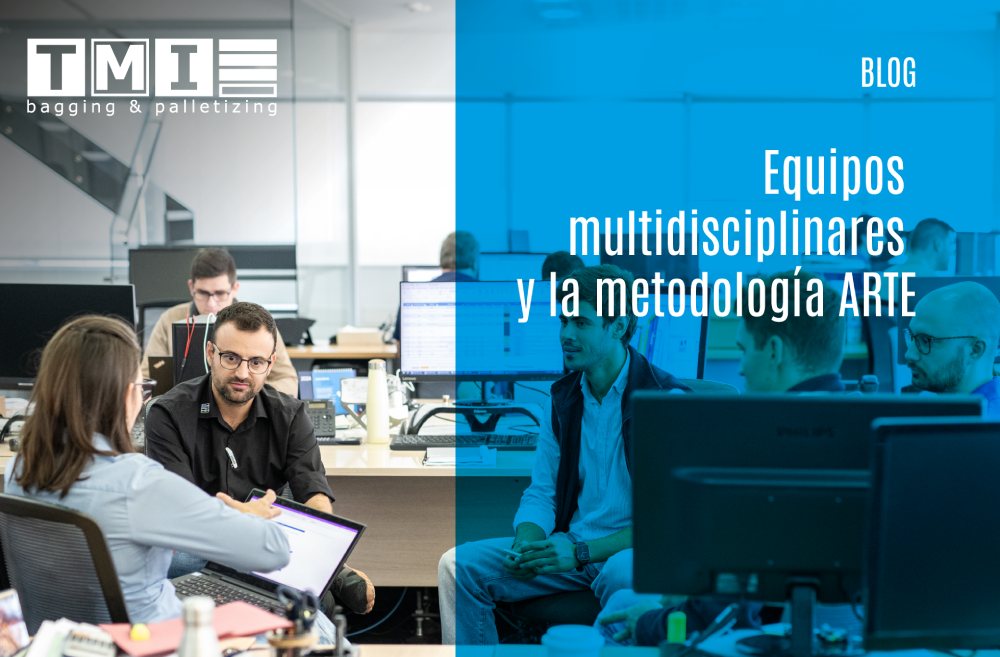
In bagging and palletizing projects, and generally in any flexible packaging or industrial process, it is essential to develop specific technical solutions tailored to the needs of each client. These projects require a personalized approach that meets precise requirements in terms of scope, cost, time, and quality. To achieve this, it is crucial to have multidisciplinary teams that work collaboratively and in a coordinated manner to ensure project success.
Project management is key to ensuring not only that customer expectations are met, but that maximum satisfaction is achieved. This type of management is aligned with the methodologies described in the PMBOK (Project Management Body of Knowledge) guide, established by the PMI (Project Management Institute). One of the fundamental concepts in this guide is the management of the triple constraint: scope, cost, and time. When quality is added, it becomes a fourth constraint, all interconnected to ensure the optimal execution of projects.
ARTE Methodology: Adaptability and Efficiency in Project Management
At TMI, we have developed our own project management methodology, called ARTE (Agile & Reliability TMI Engineering). This methodology combines the best practices of Agile and other recognized methodologies, prioritizing flexibility, continuous improvement, and fast value delivery to the client. The goal of ARTE is to ensure that each project is delivered in an agile and reliable manner, without compromising quality and adapting to changes in requirements throughout the project lifecycle. These pillars are essential to ensuring customer satisfaction in every project we undertake.
Benefits of the ARTE Methodology for the Client
- Smooth communication: The ARTE methodology ensures constant, two-way communication with the client, facilitated by follow-up meetings at every project phase and sub-phase. This ensures full visibility of the project status.
- High-quality technical documentation: We provide detailed documentation such as the Functional Description Specification (FDS), 2D and 3D plans, operation manuals, and spare parts lists, among others.
- Flexibility and adaptability: The methodology allows for agile management, quickly adjusting to any changes in requirements, layout, or deliverables.
- Maximum client satisfaction: Thanks to our methodology, we deliver customized projects that not only meet the client’s expectations but exceed them in terms of reliability, flexibility, and customization.
Project Structure with the ARTE Methodology
The ARTE methodology structures project development into a series of sub-phases and milestones designed to guarantee the best possible outcome. Each sub-phase follows a schedule that is reviewed weekly, ensuring the agreed-upon planning is adhered to. The activities in each sub-phase often include generating technical documentation for the client, as well as completing the actions necessary to meet the defined scope.
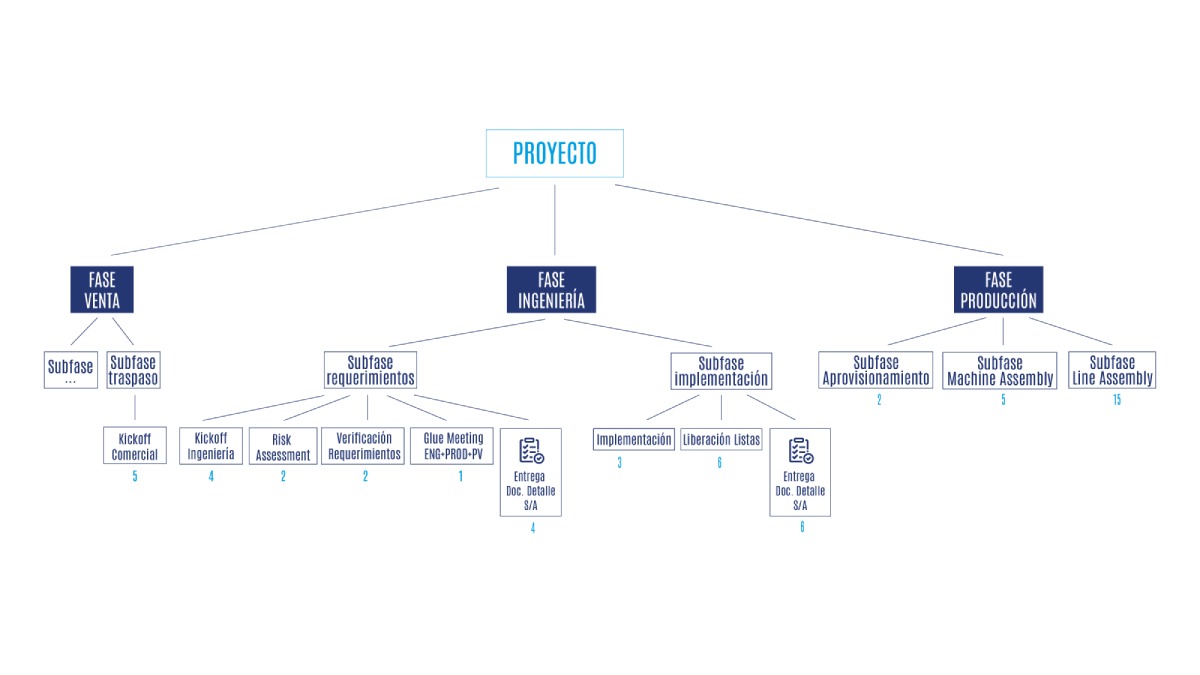 Illustration 1: Diagram of the Project Phases and Sub-phases
Illustration 1: Diagram of the Project Phases and Sub-phases
Every project is assigned a specific team, which we call an engineering cell, and we currently have four cells. Each cell is made up of four specialists with the following roles:
- Project Manager
- Mechanical Engineer
- Electrical Engineer
- Automation Engineer
These professionals work together from the beginning to the final delivery of the project, ensuring smooth collaboration at every stage. The key benefits of this collaborative approach include:
- Agile development: Project phases progress dynamically, allowing for rapid and efficient advancement in all associated content.
- Deviation management: Any deviation in the project is addressed quickly, enabling immediate adjustments and ensuring the project continues without compromising deadlines.
- Synergy between disciplines: The combination of various specialties enables continuous improvement of technical solutions, resulting in stronger outcomes tailored to the client’s specific needs.
- Constant supervision: Critical sub-phases such as procurement, machine assembly, and line setup are closely monitored, ensuring every step of the production process is executed precisely.
- Meeting requirements: This approach ensures the delivery of a product that not only meets but exceeds the client’s requirements for scope, cost, time, and quality.
This structure allows TMI to provide highly effective technical solutions, always keeping client satisfaction as a top priority.
Technical Units at TMI: Innovation and Specialized Technical Support
At TMI, we also have multidisciplinary technical units responsible for managing our portfolio of specialized products in key areas such as dosing, weighing, bagging, palletizing, and load protection. These units focus on developing new technologies, defining technical specifications, and offering advanced technical support to our clients. Thanks to this structure, TMI customers have direct access to innovative and customized solutions that improve their industrial processes.
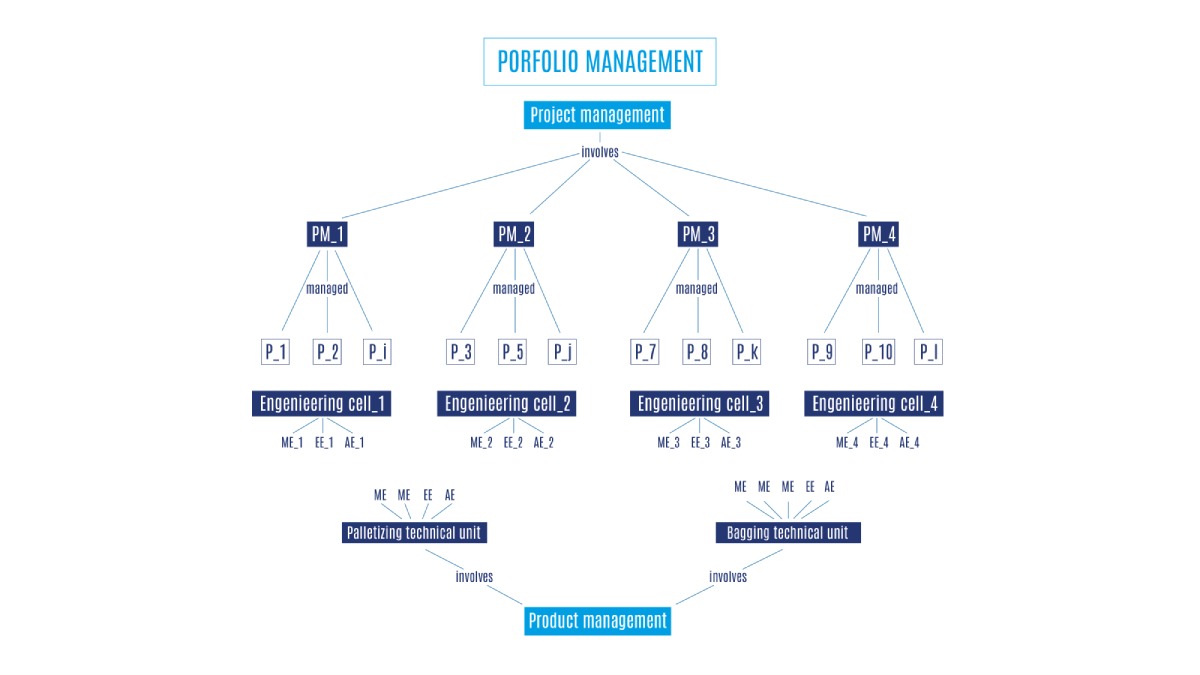
Illustration 2: Conceptual Diagram of the ARTE Organization
Commitment to Customer Satisfaction and Quality
At TMI, we are committed to delivering projects that meet the highest standards of quality and customer satisfaction. Transparency and flexibility at every project stage are essential to our value proposition. The implementation of the ARTE methodology allows us to guarantee the efficient delivery of projects, optimizing every step of the process and ensuring tangible benefits for our clients in terms of scope, cost, time, and quality.
EFFICIENCY AND SUSTAINABILITY IN HIGH-VALUE PRODUCT BAGGING - KEY STRATEGIES TO CONSIDER
August 23, 2024
Discover how advanced manufacturing techniques and forward planning when investing in bagging equipment can help you improve the efficiency and sustainability of your production processes.
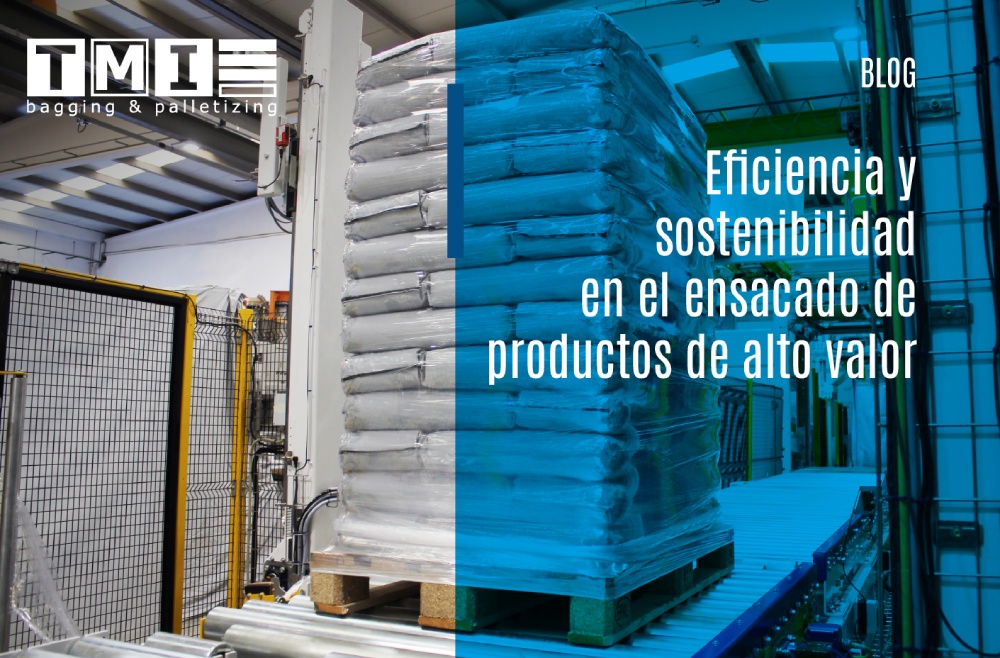
Maintaining the quality and sustainability of your product without reducing margins or making significant investments to stay competitive is a common challenge. Technology is advancing, but there is no magic formula for optimizing processes. In this blog, we focus on the most common concerns when bagging high-value-added products and the technical solutions that can mitigate these challenges, all while improving efficiency and sustainability.
OPTIMAL WEIGHING: EVERY GRAM COUNTS
In an environment where raw material costs are rising and sales margins are shrinking, weighing precision is crucial. In sectors such as food and polymer manufacturing, 100 grams of product wasted per bag can result in significant economic losses. Here, the precision of the bagging machine is essential. Gross weight weighing systems, although slower, offer greater precision and ease of cleaning, which is vital to avoid cross-contamination and optimize the bagging of technical products such as polyamides, compoundings, and masterbatch.
We delve deeper into the topic of bagging polyamides, compoundings, and masterbatch, as well as the technical aspects to consider when installing a bagging machine, in the next blog .
SUSTAINABLE PROCESS: BEYOND THE PACKAGING
Efficient bagging is key to reducing waste and promoting more environmentally friendly material handling, aligning with sustainable practices. It’s not just about reducing the size of the packaging but improving sustainability throughout the entire bagging process. Additive manufacturing, or 3D printing, has allowed for the production of lighter parts that reduce energy consumption and extend the life of components. Additionally, the ability to manufacture on-site by sending digital files instead of physical parts reduces the carbon footprint.
For plants handling numerous batches, an agile and adaptable bagging system is essential to minimize downtime. Bagging machines designed with hygienic finishes and "tool-less" concepts, which allow for quick and tool-free cleaning, optimize production and reduce downtime. Automated or assisted CIP (Clean-In-Place) systems further contribute to this efficiency. You can learn more about all its advantages in the next article.
EFFICIENT LOGISTICS: ANTICIPATION AND PROTECTION
When addressing technical solutions for the end of the line, it is crucial to consider logistical needs. It’s important to think about additional pallet protection, beyond the use of plastic, to prevent unexpected costs and ensure that the end of the manufacturing process is as sustainable as possible.
- Selecting the right bag: Choose a bag that preserves the product's properties and is compatible with bagging technology that correctly extracts air from the bag. Whatever bagging technology is applied (manual, automatic, or FFS bagging machine), it's important that the bag's sealing system is reliable.
- Load stability: Proper air extraction from the bag and the right palletizer ensure that palletized loads are more stable, reducing incidents during transport and, therefore, waste and returns. This is achieved through heat-sealing systems with air extraction nozzles, like the one you can see in this video. Additionally, this system eliminates de-aeration valves, which increase the cost of consumables.
- Pallet protection: Protect the pallet laterally with film and cardboard to prevent damage throughout the entire handling chain of your goods and minimize returns. At TMI, we have developed the ILERBOX system that protects the pallet with corrugated cardboard from a roll to prevent bag breakage due to forklift impacts. This load protection system replaces the use of the pallet box, reducing consumable costs and storage space.
The bagging of solid products continues to evolve with technological advances. The incorporation of automated techniques and advanced monitoring systems continuously improves the efficiency and accuracy of the process. Additionally, the trend towards sustainability drives the development of more efficient and environmentally friendly bagging methods, reinforcing the industry's commitment to the environment.

HOW ADDITIVE MANUFACTURING FINDS ITS APPLICATIONS IN BAGGING SYSTEMS
July 11, 2024
TMI aims to provide bagging and palletizing solutions tailored to the customer's needs for a wide variety of sectors and products with diverse behaviors.
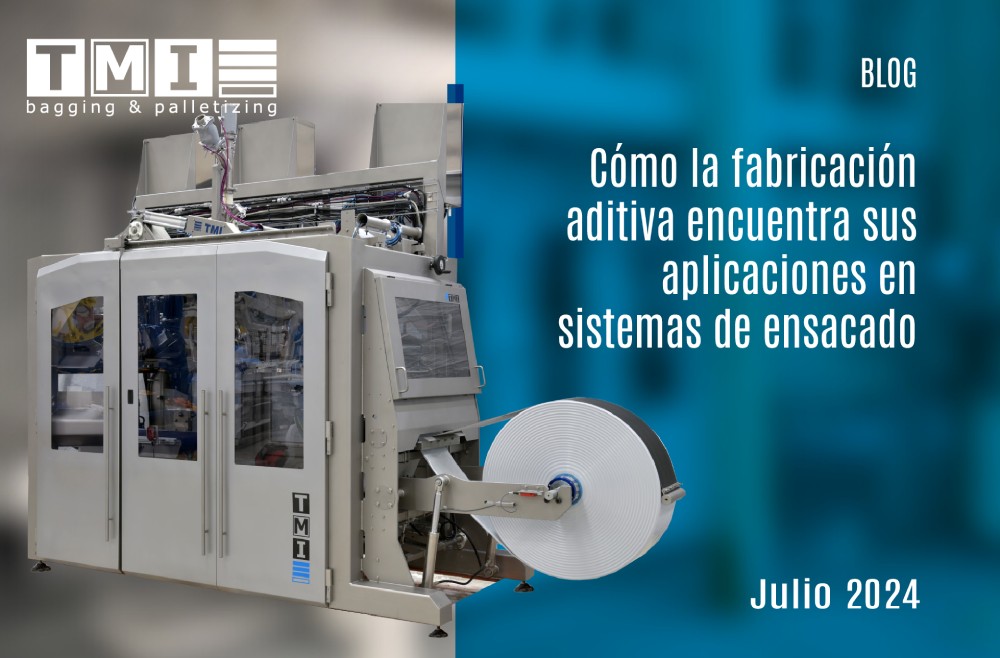
Are we talking about rockets or bagging machines?
TMI aims to provide bagging and palletizing solutions tailored to the customer's needs for a wide variety of sectors and products with diverse behaviors. This sometimes involves managing around 1000 references or more for each machine that makes up the packaging line. For TMI, a company characterized by its openness to innovation and process improvement, optimal management of design and manufacturing of parts is of vital importance.
Applications and Benefits of Additive Manufacturing (AM) in the Design of Industrial Packaging Equipment
Due to its personalized nature, many parts of a bagging machine, a palletizer, or a pallet wrapper are not mass-produced but are unique references. How can we simplify the manufacturing processes and consequently reduce delivery times, energy consumption, and compressed air usage, among others? The answer lies in the incorporation of technologies such as AM.
Optimal Manufacturing Processes
Additive manufacturing, known as 3D printing, is a constantly evolving technology that allows for the production of customized elements without involving complex manufacturing processes. This minimizes intermediate processes such as machining, laser treatments, material treatments, etc., optimizes the morphology of the parts, and at the same time minimizes the production of tooling, waste, costs, and manufacturing time.
Sustainable Solutions
These new materials and treatments reduce weights by up to 60%, making the mechanisms lighter and consequently reducing energy consumption and friction between parts, thereby extending the components' lifespan.
Innovative Materials and Shapes
In the food industry, hygienic design is crucial for the manufacturing of packaging machines. The basic criteria for a hygienic design include cleanliness, accessibility, surface design to prevent product accumulation or facilitate drainage, and the use of corrosion-resistant, non-toxic materials that prevent cross-contamination. The 3D manufacturing of parts has enabled us to create designs with morphologies that perfectly meet these requirements and to choose materials that comply with FDA and/or regulation 10/2011/EU, making them suitable for contact with food products.
Additive Manufacturing is No Longer Science Fiction
It is well known that the application of AM for metal parts is already a reality in sectors such as aerospace and medical. In the industrial machinery manufacturing sector, more accessible solutions are being presented. Although costs remain high and parts require some post-processing, it is expected that in the short term, their use will become as normalized as plastic parts, as these challenges are overcome. This technology has arrived to improve productivity in manufacturing processes and positively impact technological solutions in the Flexible Packaging sector and machinery manufacturing in general.
With the help of 3D printing, we have designed solutions that have allowed us to adapt to the particularities of the customer's project. Want to know an example? Contact us and we will explain.
Contacta con nosotros y te lo explicamos.
How Sound Measurement Helps Us Meet Safety Standards
May 15, 2024
Our Commitment to Operator Hearing Health
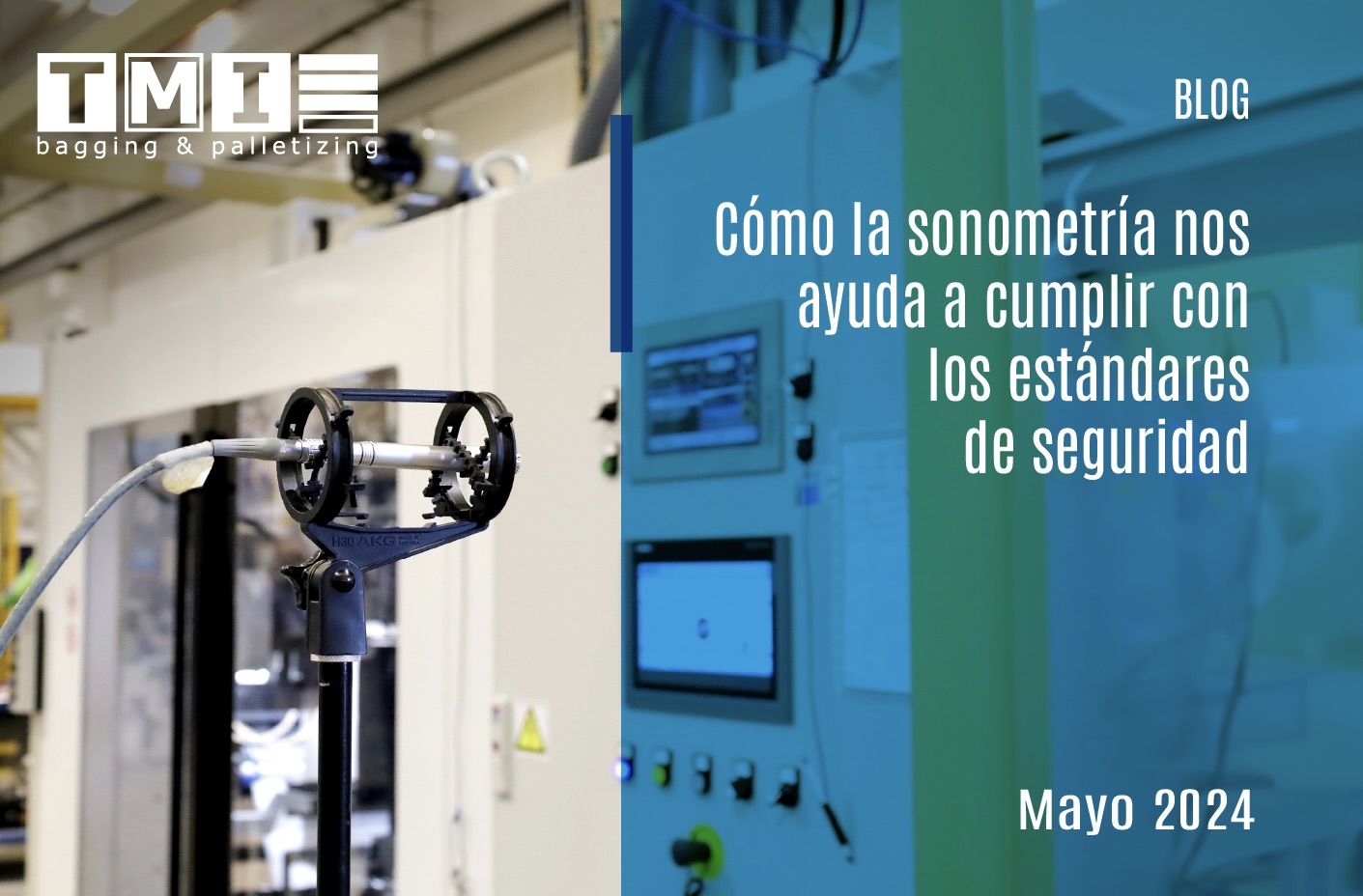
At TMI, we are committed to excellence in manufacturing our machines, ensuring they not only operate optimally but also meet the highest safety standards. A crucial aspect related to operator safety is the level of noise and the exposure time they may experience during normal operation.
Directive 2006/42/EC requires indicating the emitted noise level, while RD 286/2006 on the protection of health and safety of workers sets a limit of 85 dB(A) as the maximum allowed, beyond which hearing protection is required for workers. Although our machines are highly automated and operator presence is not continuous, we strive to minimize noise emission levels, aiming to keep them below the 80 dB(A) threshold. These values ensure that operators can work in a comfortable and safe environment.
We collaborate with reputable entities in inspection, testing, and certification to carry out necessary tests, following the guidelines established in standard EN-415-9, specific to our range of machinery. Multiple acoustic measurements are taken at corresponding perimeter points, considering variables such as sacks produced per hour, dimensions, and weight of the produced sacks.
It's important to consider the environment where measurements are taken, as factors like room dimensions and materials can influence sound propagation. To correct for this effect, we emit a known sound and then analyze the measured result at the test site. Thanks to these corrective measures, we obtain more precise and reliable results.
The final result is a "weighted A-weighted sound pressure level" as accurate as possible, which meets our goal of staying below 80 dB(A). This exempts us from calculating the "weighted A-weighted sound power level," as stipulated in the Machinery Directive. At TMI, we strive to ensure a safe and comfortable working environment for all our operators, meeting the highest standards of quality and safety.
The distinctive value of the after-sales department at TMI
April 02, 2024
Commitment to after-sales service, strengthening bonds, and building trust through adaptability and continuous excellence.
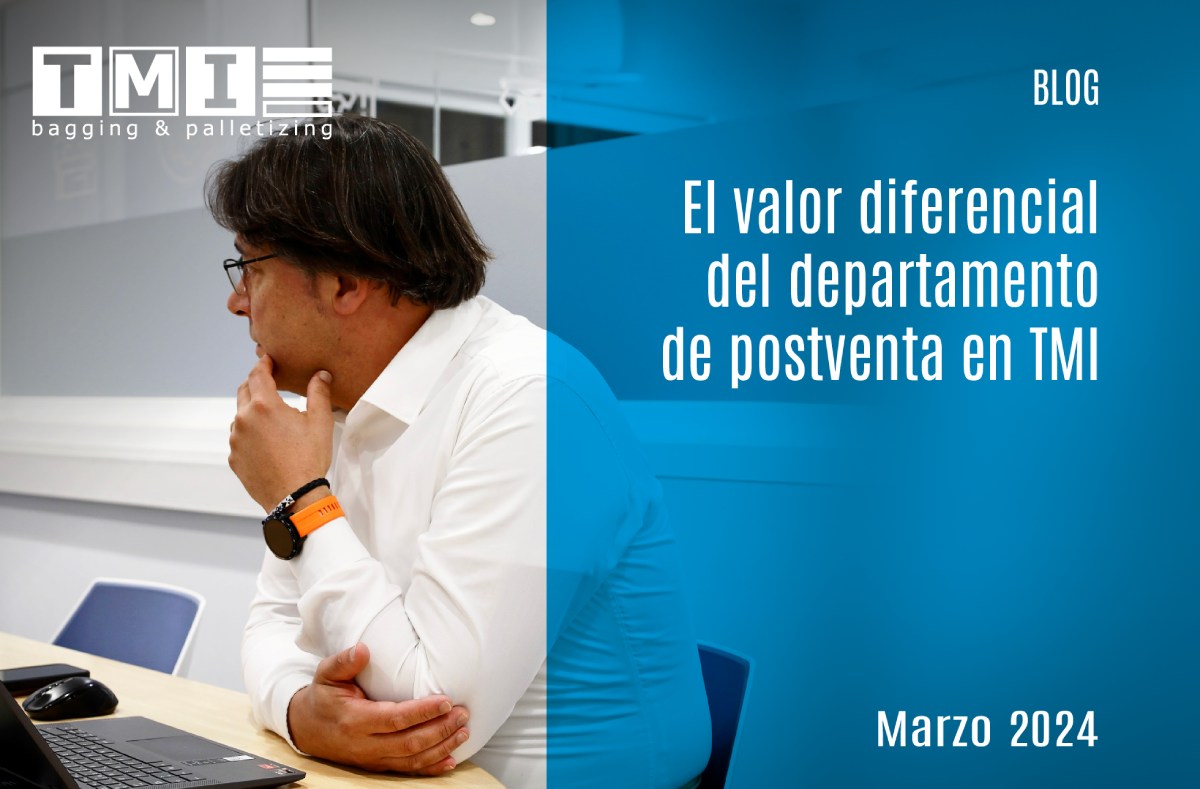
Commitment to after-sales service, strengthening bonds, and building trust through adaptability and continuous excellence.
In the industrial bagging sector, beyond machinery and automation, lies a crucial pillar: the after-sales department. This team not only represents the final stage of a transaction but goes further, acting as the link between the end customer and the company.
When a customer chooses TMI, the sale does not end with the delivery of the machinery. It initiates a new phase: after-sales. This department stands as the vital bridge connecting the customer's needs during, before, and after the implementation of our machinery.
Each installation presents unique and different challenges. For example, a customer may face a transition from manual operations to automation. Here is where the after-sales department plays its critical role, offering continuous support, unparalleled backup, and a connection that goes beyond mere machinery operation.
Among the concerns of the after-sales department are common difficulties such as technical product knowledge and uncertainty about reliability. TMI recognizes that these minor variables can significantly impact the final outcome. Therefore, customer training in maintenance and production areas is a priority.
The methodology of the after-sales department encompasses both proactive and reactive approaches. From direct monitoring by TMI to receiving direct feedback from the customer, the department works to anticipate and address any issues. Post-implementation surveys, specialized follow-ups, and continuous evaluation are standard practices at TMI.
Providing exceptional customer service is crucial for establishing strong trust relationships. Creating a community where customers can share experiences and utilize their feedback to improve both customer service and products is a strategy deeply valued by TMI.
What sets TMI apart in after-sales management goes beyond compliance with regulations. The ability to adapt to specific customer needs, provide technical training, and maintain comprehensive commitment to each project are standout features. After-sales is not just a phase but a continuous cycle that reinforces the customer relationship and provides a unique competitive advantage in the sector.
In summary, the after-sales department at TMI not only offers machinery but provides comprehensive, safe, and efficient solutions, setting a high standard in after-sales management in demanding industrial environments.
Palletizer Selection Guide: Find the Ideal Solution for Your Business
February 29, 2024
Discover how choosing the right palletizer can transform your palletizing operations, enhancing efficiency and safety on your production line.
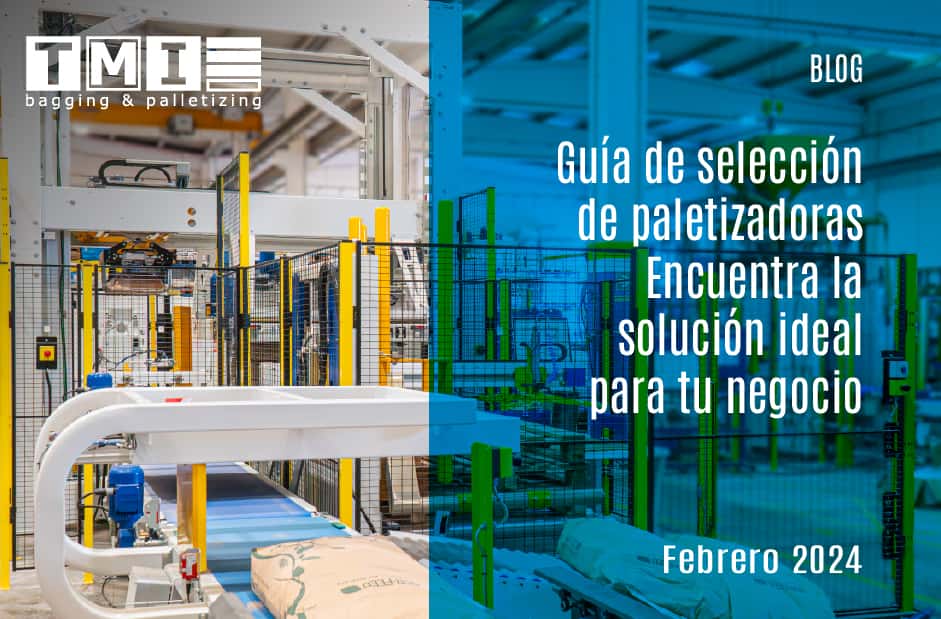
Discover how choosing the right palletizer can transform your palletizing operations, enhancing efficiency and safety on your production line.
In the world of palletization, selecting the appropriate type of palletizer is crucial. In this blog, we will explore the various types of palletizers that TMI offers, providing an objective and consultative perspective to meet the specific needs of each customer.
Palletization is the process of automating and stabilizing the load, ensuring efficient and safe handling of products.
In the vast world of palletizers, there are different approaches to tackling the task of organizing and stabilizing the load on a pallet. We present a detailed overview of two main categories: palletizers that form layers and those that do not.
Palletizers that do not form layers (robots and gantry)
Within this category, two main types stand out:
Robotic Palletizers
Robotic palletizers, with their anthropomorphic design, bring a high level of automation and reliability to product handling. It is a robotic arm that picks up bags, boxes, bales, and places them on a pallet with mathematical precision, usually using a gripper or vacuum system.
They are particularly efficient when it comes to managing substantial volumes, providing a quick and precise approach to palletization. However, it is important to note that, compared to other systems, robotic palletizers may have limitations in terms of the quality of load arrangement.

Gantry Palletizers
Gantry-type palletizers, also known as Cartesian palletizers, offer an automated approach, though at a slightly slower pace compared to their robotic counterparts.
This type of palletizer is versatile and suitable for various applications, making it a feasible option for those seeking automation with flexibility. They are primarily used for end-of-line applications with production levels ranging from low to medium (up to 420 bags/hour), where bags need to overlap (easy-open bags), although they can also palletize valve bags or FFS-type bags seamlessly.
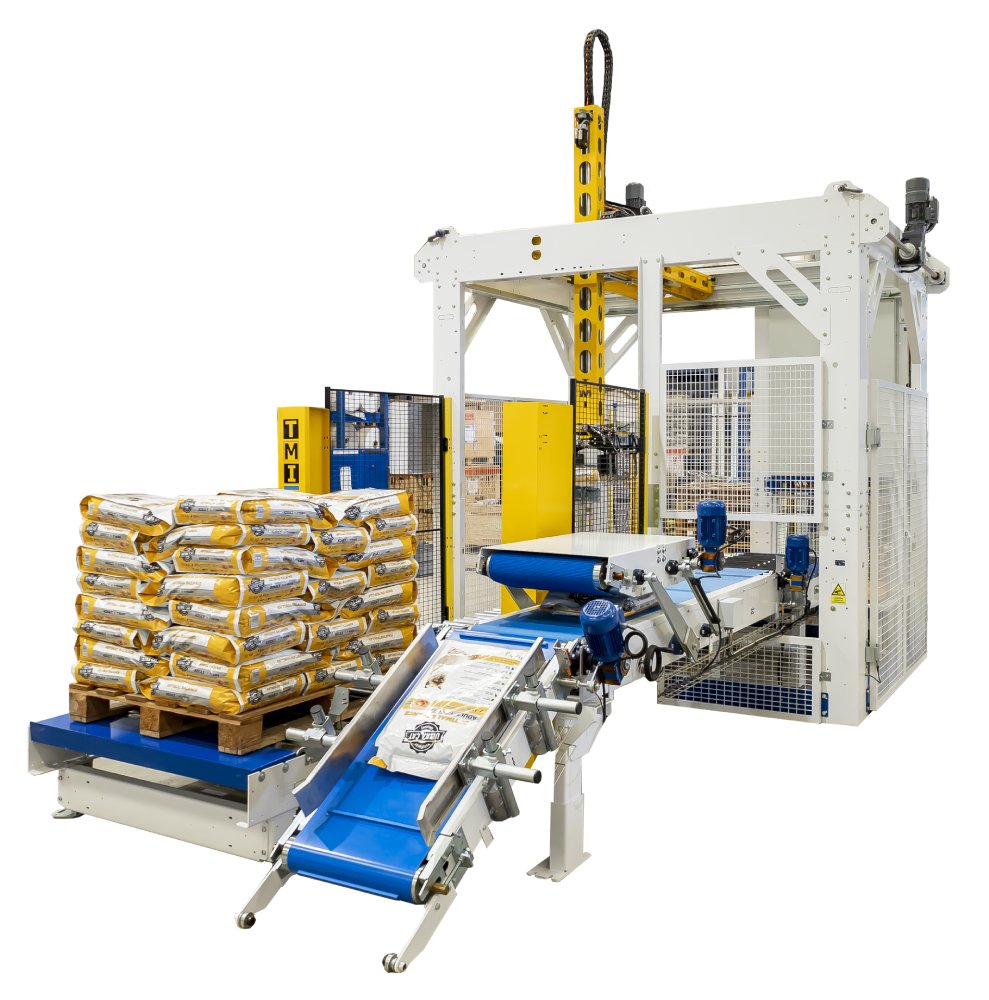
Palletizers that form layers
In this category, palletization is addressed by forming layers. This approach prioritizes quality by organizing product layers precisely and stably. Load stability is established as the key criterion for evaluating the performance of these palletizers. This method aims to ensure that the load arrangement is optimal in terms of stability and presentation.
This type of palletization works as follows: bags are elevated to the palletization position, i.e., the layer-forming platform, where four side devices are responsible for pulling the bags and forming each layer. The layers are placed directly on gates that open to stack each one on top of the previous.
Layer palletizers are an excellent choice for medium to high productions where products are bagged in valve or FFS bags that do not require overlapping.
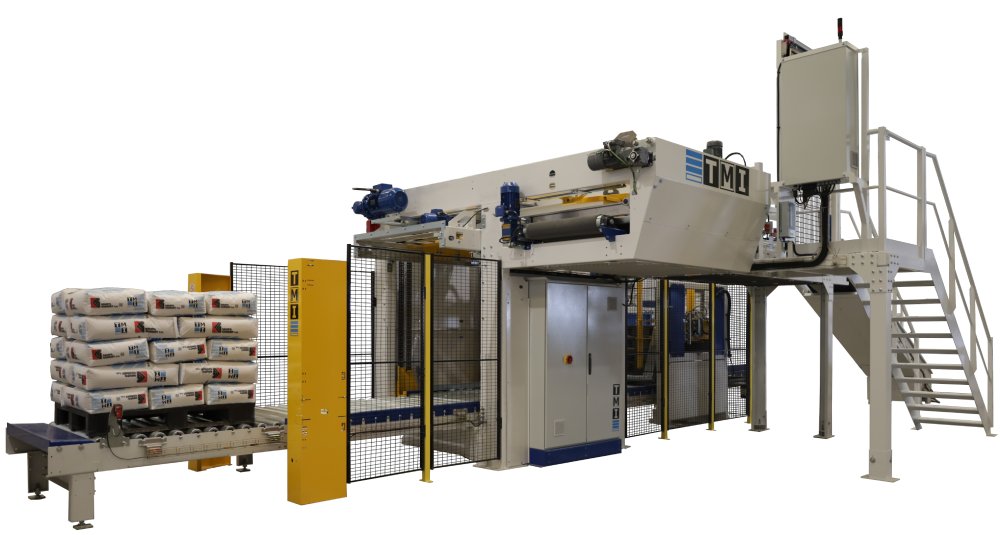
Hybrid Palletizers
Hybrid palletizers have been designed with the purpose of palletizing easy-open bags at high speeds. These systems merge features of robotic palletizers and layer palletizers to achieve superior levels of efficiency in the palletization process of easy-open bags.
Although they share similarities with high-performance palletizers, hybrid palletizers use robotic grippers and Cartesian axis systems for layer formation, always assisted by lateral pushers. This way, enhanced performance is achieved, preserving the integrity of the bag and ensuring optimal pallet stability.These different types of palletizers offer specialized solutions for various needs, allowing customers to select the option that best suits their specific palletization requirements.
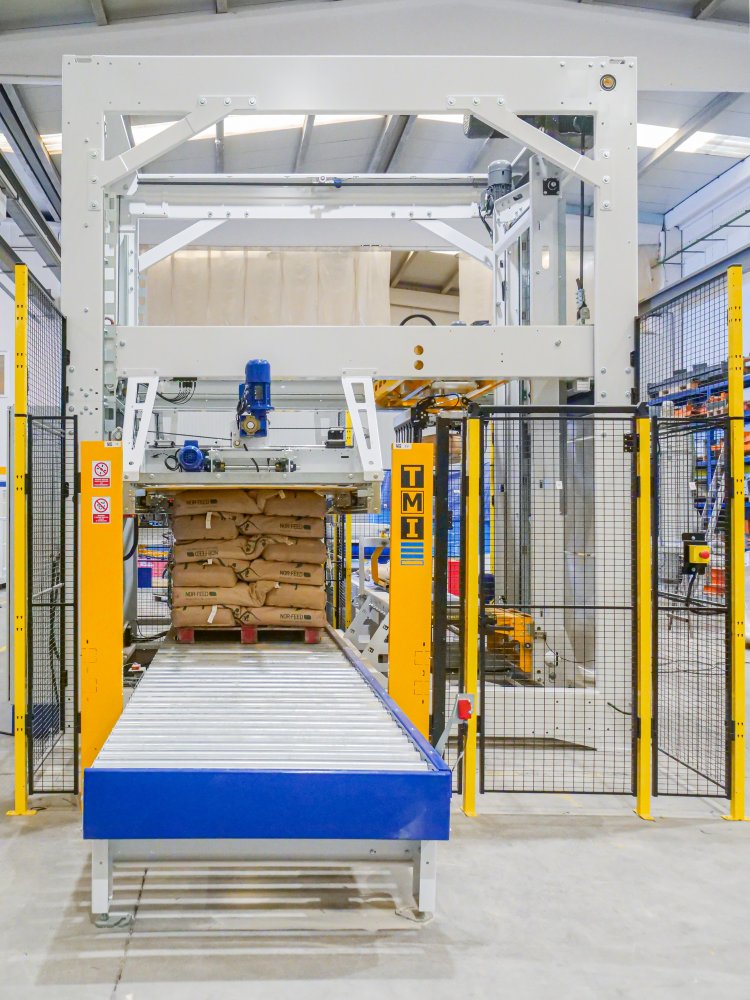
Key factors for palletizer selection:
Production speed (bags per hour):
Production speed is crucial for maintaining workflow and meeting demand. A palletizer that does not meet the speed requirements set by the customer or product can create bottlenecks in production. Current and future capacity should be evaluated, considering possible expansions or increases in demand.
Bag type (overlapping or not):
The type of bag has a direct impact on how materials are handled during the palletization process. Some palletizers may be more suitable for certain bag types than others. It is essential to consider factors such as material strength, bag shape and size, as well as ease of stacking.
Maximum pallet height:
Maximum pallet height influences load stability and storage and transportation capacity. Height restrictions in storage and transportation must be considered, along with compliance with relevant safety regulations.
Available space in the factory:
Space availability can limit the choice of palletizer type and size that can be installed. Measuring available space is crucial, taking into account the need for storage areas or maneuvering space around the palletizer.
Need for simultaneity on multiple lines:
The ability to handle multiple production lines simultaneously can be crucial for large and diversified operations. It should be assessed whether a centralized system capable of managing multiple lines is required or if it is more suitable to have independent systems.
With over 25 years of dedication and experience in the industry, TMI has established itself as an expert reference in industrial palletization solutions. The company stands out for its ability to offer customized responses to each challenge, supported by a solid knowledge accumulated over the years.
In particular situations, such as projects related to the human or pet food sector, TMI has faced challenges that have required more complex palletizing solutions. These specific challenges have driven the continuous development of the company, resulting in a diverse range of six palletizing solutions. Each of these solutions has been conceived to address the unique needs of different contexts and products.
The ILERPAL L palletizer stands out as a concrete example of TMI's balanced philosophy. This solution not only offers cost competitiveness but also ensures exceptional levels of quality and automation. ILERPAL L exemplifies TMI's commitment to finding the perfect balance between the benefits provided by the solution and the investment made. It represents a versatile and efficient option that responds to changing market demands and the specific needs of each customer.
Discover Ilerpal L - view video
At TMI, we not only offer palletizers but solutions tailored to every challenge, raising the standard in the industrial palletization industry. Consultative selling based on our experience is the cornerstone of our approach to help customers make the best decision.
Ready to discover the perfect solution for your palletization? Contact us now!
KEY ASPECTS OF ATEX APPLICATIONS: TMI'S EXPERIENCE
January 30, 2024
Operational Strategies for Risk Prevention in ATEX Zones.
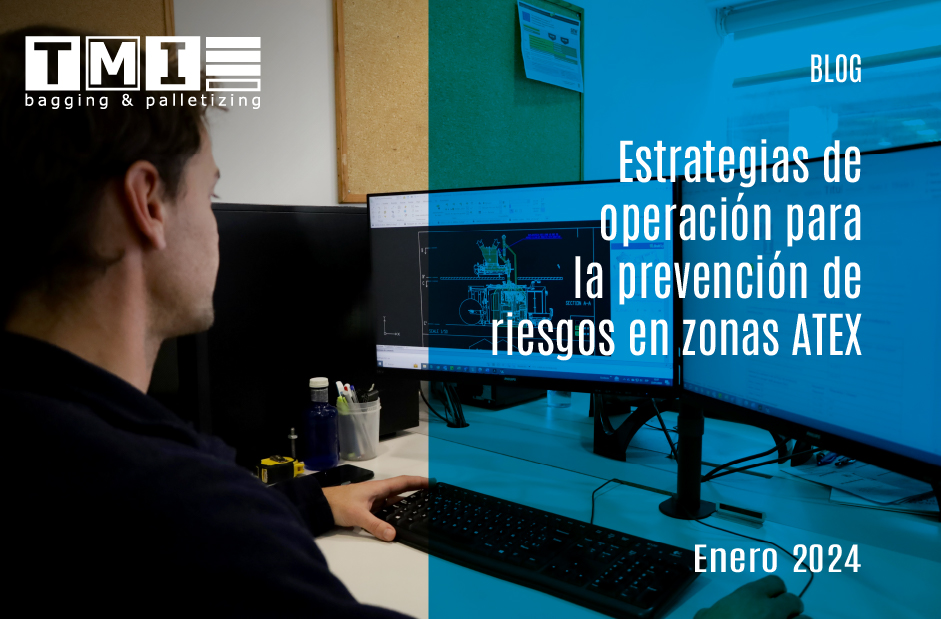
Operational Strategies for Risk Prevention in ATEX Zones
In this article, we would like to share certain relevant aspects of ATEX "ATmosphère EXplosible" applications, specifically those involving powdered products, based on the accumulated experience of TMI in the various solutions it has developed.
For over 15 years, TMI has been undertaking packaging projects for applications where powdered products that can create an explosive atmosphere, ATEX, are handled. Safety requirements for both the process and operators are of utmost importance in these projects. Therefore, we continue to invest heavily in knowledge, training technicians, and designers to offer the best solution in each case.
Over these 15 years, many projects have been successfully completed, adapting to the specific requirements of each application, collaborating with clients and other stakeholders to determine the best solutions. These solutions prioritize three crucial aspects: safety, simplicity of solutions, and optimal investment cost.
Based on this experience, we would like to share the following key points that help define a technical solution for ATEX products correctly:
DPCE o DOPEX
The Explosion Protection Document (DPCE) is a mandatory document for companies working with explosion-prone products. It involves risk assessment, area classification, and the implementation of appropriate measures to meet the minimum requirements set in RD 681/2003, ensuring that work equipment is used safely. If the company's knowledge on this topic is insufficient, external entities are available to provide guidance in its development. Being aware of existing risks and necessary mitigation measures is the first step in ensuring worker safety.
Caracterización del producto
To analyze a project correctly, maximum information about the product is required. This starts with having as much data as possible about the product, making it essential for critical client products to be well-characterized through the corresponding analysis, resulting in a Safety Datasheet. Parameters that often affect machine design for ATEX atmospheres include:
- Minimum Ignition Energy (MIE): This parameter is especially relevant when its values are very low (between 1 and 20 mJ), as in such cases, a dust cloud could explode under certain conditions with very low energy, such as that generated by a small electrostatic discharge. Particle size distribution plays a significant role in this parameter, as smaller particle sizes result in lower MIE (greater surface area relative to volume means easier ignition).
- Temperatura de autoignición: The temperature at which the product ignites directly influences the maximum temperatures of components integrated into the machine. A sufficient safety margin must always be considered, depending on whether the explosion is through a dust cloud or a dust layer.
Zoning
It's important for the client to seek advice on crucial aspects such as zone classification. As manufacturers, a proper zoning process relies on understanding the machine and how the product behaves inside it. Another critical detail is the extent considered for each zone. To determine this, TMI performs calculations based on existing regulations, technical documents, and factors like product properties, height of potential release sources, and ventilation characteristics of the facility, among others.
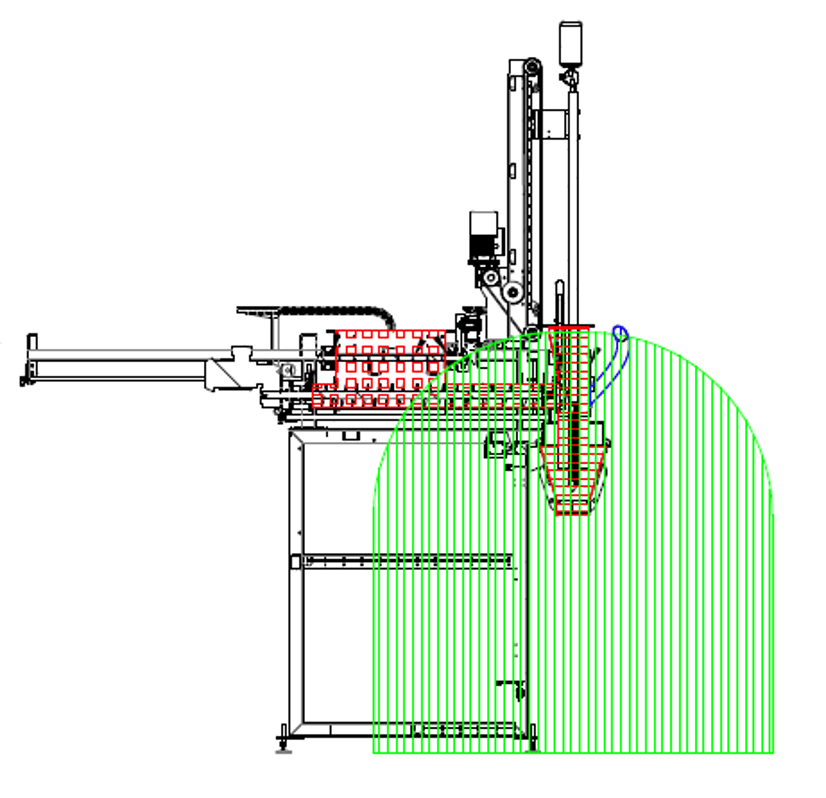
Correct zoning prevents the client from overclassifying their installation, avoiding unnecessarily extensive ATEX zones or more restrictive zones (higher classification levels). This has a significantly negative impact on the client, affecting various aspects:
Substantial increase in machine costs:- Requirement for more restrictive personal protective equipment, such as special clothing to prevent electrostatic energy accumulation.
- Increased costs due to the use of certified external equipment (dust extractors, forklifts, etc.) and fixed infrastructure in classified areas (lighting, ventilation, fire protection, etc.).
- Prohibition of uncertified devices, mobile electronics, etc., in the classified zone.
Need for much more restrictive operational procedures.
Importance of Operational Procedures
To ensure safety in an ATEX installation, it is essential to establish a series of procedures and ensure their compliance.
Cleaning procedures in an explosive atmosphere facility are crucial for various reasons:
- • Proper cleaning prevents the accumulation of dust layers, which, if present, can create explosive atmospheres when disturbed, leading to an increase in the classified zone (increased cost).
- • Simultaneously, a layer of dust on certain parts of the machine can lead to increased temperatures, creating a potential ignition source (higher risk).
Maintenance procedures are also essential in such installations, as they help detect wear and tear on certain elements in their early stages, preventing unintended product releases at unexpected points, which would also result in an expanded classified zone.
Discovering TMI's Laboratory: Where Innovation Takes Shape
December 15, 2023
Within the facilities of TMI lies our laboratory, a dynamic and crucial space that plays a fundamental role in our mission to deliver cutting-edge bagging and palletizing solutions.
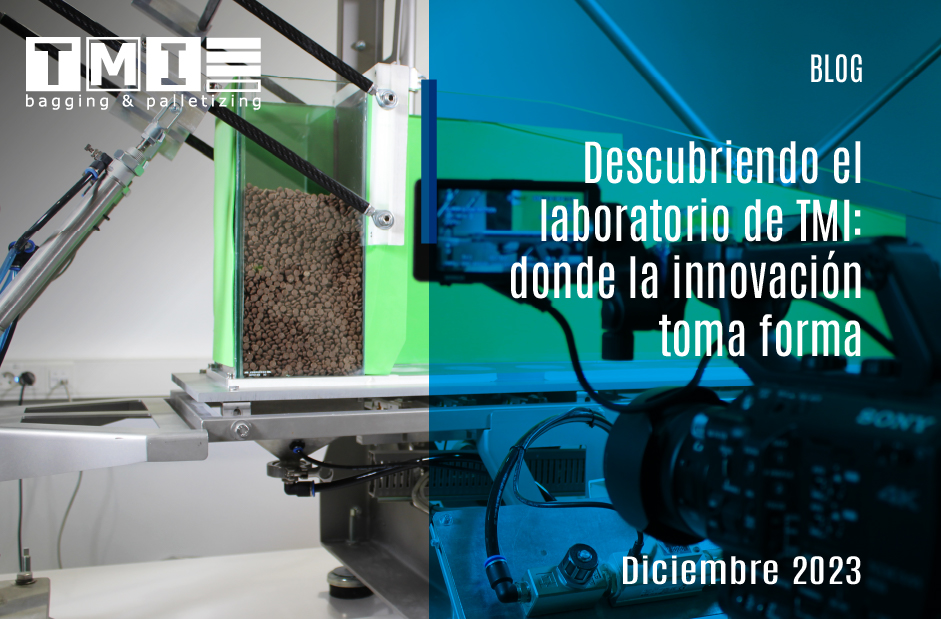
Within the facilities of TMI lies our laboratory, a dynamic and crucial space that plays a fundamental role in our mission to deliver cutting-edge bagging and palletizing solutions. Here, we explore how this specialized resource enhances not only our capabilities but also the experience of our customers.
TMI LABORATORY
Diversity of Products, Diversity of Approaches
TMI's laboratory emerges as a stage where each product undergoes rigorous testing. The reason? Every product has its own peculiarities and behaviors during bagging. The versatility of our laboratory allows us to adapt to these variables, finding optimal and personalized solutions.
The Testing Ground for Innovation
We don't always resort to the laboratory, but its existence becomes relevant when facing the complexity of products yet to be fully explored. Here, we confront the key question: How can we ensure that a machine designed for one set of products functions efficiently with others? The answer: our testing ground.
WHEN AND HOW DO WE UTILIZE THE LABORATORY?
1. In the bidding phase: designing success from the start
The laboratory plays a crucial role in ensuring the best option during the initial phases. Here, we evaluate if a product has more than one viable solution and what the best solution for the customer is, adding a component of commercial value even before signing the contract.
2. In post-sales inquiries: maintaining continuous excellence
Even after a customer has purchased a machine, the laboratory remains essential. When the question arises of whether a new product can be processed with the existing machine, the laboratory helps provide detailed reports to expand our product know-how and, above all, to add value to our customers.
THE INVALUABLE BENEFITS OF THE TMI LABORATORY
Adding value to the customer by aligning their expectations with the most suitable technical solution
Minimizing errors, maximizing efficiency
The laboratory becomes the first line of defense against costly errors. With quick and accurate adjustments, we ensure that our machines adapt perfectly to each product.
Building trust and ensuring long-term success
Beyond operational efficiency, the laboratory reinforces customer confidence. When everything runs smoothly, customer satisfaction rises, ensuring strong and lasting relationships.
A differential factor in the industry
It is not common to find specialized laboratories in companies in the industrial bagging sector. This differential factor highlights TMI's commitment to excellence and innovation, setting the standard in the industry.
In conclusion, our laboratory is not simply a testing space; it is the epicenter where innovation, precision, and excellence converge to ensure the continuous success of each project and meet the expectations of our customers. At TMI, we not only manufacture machinery; we create solutions tailored to every challenge, thus raising the standard of the industrial bagging industry.

TMI Técnicas Mecánicas Ilerdenses SL in the framework of the ICEX Next Program, has been supported by ICEX and co-financed by the European ERDF fund. The purpose of this support is to contribute to the international development of the company and its environment.

TMI, en el marco del Ministerio de Industria y Turismo, ha desarrollado un proyecto titulado 'Implementación de mejoras integrales a los procesos, calidad y trazabilidad de TMI', subvencionado por dicho ministerio y financiado por la Unión Europea a través de Next Generation EU, en el marco de la convocatoria de apoyo financiero a planes de innovación y sostenibilidad en el ámbito de la industria manufacturera 2022.

Company
Industries
Services
Address
Polígono Industrial Camí dels Frares,
C/ Alcarràs, parc 66 - 25190 - Lleida · SPAIN Tel.
+34 973 25 70 98



